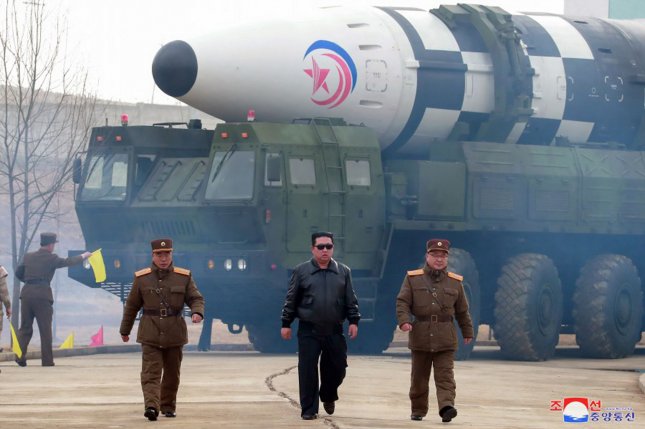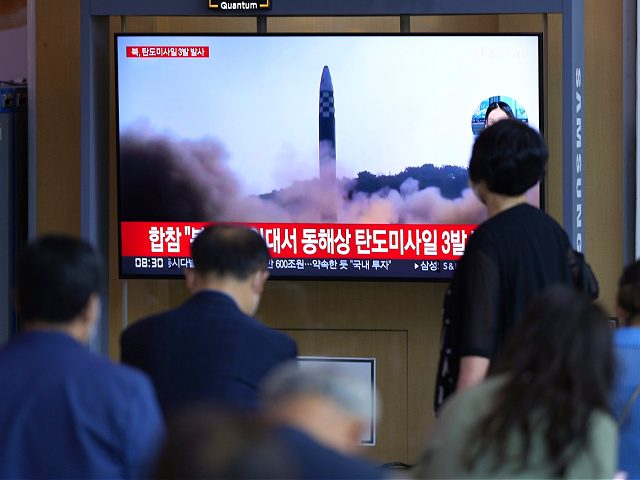South Korean military officials told reporters on Wednesday that one of three missiles launched by the communist regime in North Korea that day was likely the Hwasong-17, the most advanced of Pyongyang’s intercontinental ballistic missiles (ICBMs).
A top official in the newly minted administration of conservative South Korean President Yoon Suk-yeol also told reporters on Wednesday that South Korea has reason to believe that dictator Kim Jong-un is revamping the Punggye-ri Nuclear Test Site and appears to be testing a nuclear detonator.
North Korea has tested six nuclear bombs in its history, four under President Joe Biden’s former boss, Barack Obama. Biden visited South Korea and Japan last week for, among other things, his first in-person meeting with Yoon since the latter took office on May 10. North Korea has rejected all of the Biden administration’s attempts to communicate and has repeatedly mocked Biden as “feeble” and “senile.”
The communist regime in Pyongyang did not publicly comment on Biden’s presence in the region while he was there.
South Korea’s Joint Chiefs of Staff (JCS), its top military agency, confirmed on Wednesday that North Korea launched three ballistic missiles.
“Military authorities said they thought the first missile might have been the North’s newest ICBM, the Hwasong-17, which they said flew approximately 360 kilometers (224 miles) and reached a top altitude of 540 kilometers,” South Korea’s JoongAng Ilbo reported. “Officials said the second missile, believed to be a short-range ballistic missile (SRBM), reached an altitude of around 20 kilometers before ‘vanishing’ in apparent disintegration.”
Officials identified the third as another SRBM.
First deputy director of the National Security Office Kim Tae-hyo, a Yoon executive official, confirmed to reporters in a separate press event that the ICBM launched appeared to be the Hwasong-17.
“The fact that they began the provocations around the time that U.S. President Joe Biden was entering his country’s airspace was a strategic message to both South Korea and the United States,” Kim said, according to the South Korean outlet Yonhap, noting that Biden was departing Asia to return to Washington as the launches occurred.

In this photo distributed by the North Korean government, North Korean leader Kim Jong-un, center, walks around what it says a Hwasong-17 intercontinental ballistic missile (ICBM) on the launcher, at an undisclosed location in North Korea on March 24, 2022. (Korean Central News Agency/Korea News Service via AP, File)
The Hwasong-17 made a flashy debut launch in March in a photo spread in the North Korean government newspaper Rodong Sinmun, featuring photos of the missile being displayed before Kim Jong-un, dressed in a leather jacket and sunglasses in a look reminiscent of the 1980s blockbuster Top Gun. At the time, Rodong Sinmun claimed the Hwasong-17 was “a new type inter-continental ballistic missile” that would “creditably perform its mission and duty as a powerful nuclear war deterrent.”
Kim, the Yoon administration official, told reporters that South Korea had reason to believe that another nuclear weapons test was imminent — specifically, that the communist regime had tested a nuclear detonator.
“Operation tests of a nuclear detonation device, which are to prepare for the seventh nuclear test at Punggye-ri, are being detected,” Kim said. “The possibility of an imminent nuclear test in the next day or two is low, but after that, there is certainly a possibility.”
Kim, the Yoon official, added that he could not predict when the nuclear test would occur because “it’s likely the North Korean leader has not decided himself.”
South Korea has been making similar warnings for much of May. Prior to Biden’s visit to the country, the South Korean National Intelligence Service (NIS) warned that “all preparations have been completed” for a nuclear test in North Korea.
Biden administration National Security Adviser Jake Sullivan revealed at the time that American officials had similar evidence of either the preparation of a missile launch or a nuclear test.
“Our intelligence does reflect the genuine possibility that there will be either a further missile test, including long-range missile test, or a nuclear test, or frankly both in the days leading into, on or after the president’s trip to the region,” Sullivan said.
North Korean state media did not comment on Biden’s trip to Asia and has not reported on the missile tests on Wednesday at press time. The vast majority of space in Rodong Sinmun and the Korean Central News Agency (KCNA), the largest national-level state propaganda outlets, is dedicated to the ongoing Chinese coronavirus epidemic in the country. North Korea claimed to have not documented a single case of coronavirus within its borders for two years before abruptly admitting to upwards of one million cases of the disease in less than one week of May.
“The people in the DPRK [Democratic People’s Republic of Korea] go all out for a scientific and lightening anti-epidemic campaign, full of confidence, under the experienced guidance of the Workers’ Party of Korea,” KCNA proclaimed on Wednesday. “The central emergency epidemic prevention sector and the emergency anti-epidemic units at all levels wage a campaign for curbing the spread of the pandemic disease and eliminating its root cause, while engaging in the preparatory work for reacting against any future threats and challenges.”
Kim Jong-un most recently warned North Koreans to prepare for nuclear war at a massive military parade in late April — now considered a likely superspreader event for Chinese coronavirus.
“The fundamental mission of our nuclear forces is to deter a war, but our nukes can never be confined to the single mission of war deterrent even at a time when a situation we are not desirous of at all is created on this land,” Kim said at the parade. “If any forces try to violate the fundamental interests of our state, our nuclear forces will have to decisively accomplish its unexpected second mission.”

COMMENTS
Please let us know if you're having issues with commenting.